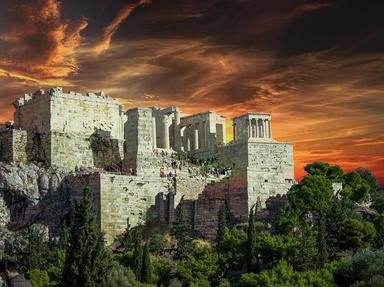Quiz Answer Key and Fun Facts
1. Lerna is located in this fertile region of the Peloponnese, home to the larger and more powerful sites of Argos, Tiryns, and Mycenae.
2. The earliest structure at Lerna, a small house with stone foundations, dates to the Middle Neolithic period. About how long ago was this?
3. About 3000 BC, during the Early Helladic II period, the settlement at Lerna began to flourish. The residents built a number of small houses and encircled the settlement with a fortification wall. What materials, the standard construction materials even into the Mycenaean Age, were used to build this fortification wall?
4. After some period of time, the circuit walls went out of use, and construction began on a large new structure at the center of the settlement-- the House of the Tiles. Which of these statements about the House of the Tiles is NOT correct?
5. The House of the Tiles was destroyed in a large fire. At the time, all of the structural elements had been completed, including the roof. However, the walls of the ground floor had not been fully plastered, and only a few artifacts and pieces of pottery were found inside the building. Was the House of the Tiles probably finished at the time it was destroyed?
6. We know for certain that waves of invaders caused the general destruction of the House of the Tiles and the rest of the Lerna settlement at the end of the Early Helladic II period. But who exactly were these invaders?
7. The invaders settled in Lerna during the Early Helladic III period, bringing their own distinctive architectural style. Houses consisted of three rooms in a row. The first room was basically a covered porch. It was used for craft production and cooking, things that needed light and had a risk of burning the house down. The family slept in the middle room. They kept their most valuable possessions-- their livestock-- in the third room, which could only be entered through the sleeping area. This three-room-in-a-row floor plan gave rise to which staple of Mycenaean palace architecture?
8. The invaders seem to have recognized that the House of the Tiles was special (after they had burned it down, unfortunately). They covered it with an artificial circular mound, outlined with stones and centered on the structure exactly. What is this sort of artificial circular mound known as?
9. We skip the Middle Helladic period, since life continued in much the same way as it had in the Early Helladic III period. In the beginning of the Late Helladic period, better known as the Mycenaean period, several Mycenaean shaft graves were sunk through the Early Helladic III tumulus and the House of the Tiles itself. These shaft graves were contemporary to the shaft graves of Grave Circle A and Grave Circle B from which other famous Mycenaean site nearby?
10. Even after all the excitement with the House of the Tiles, the tumulus, and the shaft graves, Lerna only makes a cameo appearance in Greek mythology. Which hero slayed the Lernian Hydra as his second labor?
Source: Author
pu2-ke-qi-ri
This quiz was reviewed by FunTrivia editor
bloomsby before going online.
Any errors found in FunTrivia content are routinely corrected through our feedback system.
